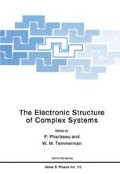Abstract
The first applications of density-functional theory to disordered systems are described. The usual difficulty of solving the single-particle Schrödinger equation for systems lacking long-range order is circumvented by using the cluster-expansion method of Sanchez and deFontaine to describe the alloy, and deducing the coefficients appearing in this expansion from energy-band calculations for several ordered compounds. The cluster expansion obtained in this way describes the alloy as a continuous function of stoichiometry, short-range order and volume. We have used the technique, in combination with an approximate description of the entropy of mixing, to calculate the dominant features of the phase diagrams of 28 transition-metal alloy systems. Agreement with measured phase diagrams is generally very good. Not tested in these first applications of the technique is its ability to describe properties of disordered systems other than the total energy, properties such as the state density. Also not yet tested is the ability of the technique to directly predict the degree of short-range order present in the system, by minimization of the free energy.
Access this chapter
Tax calculation will be finalised at checkout
Purchases are for personal use only
Preview
Unable to display preview. Download preview PDF.
References
W. Kohn and L.J. Sham, Phys.Rev. 140, A1133 (1965).
A.R. Williams and U. von Barth, “Applications of Density-Functional Theory to Atoms, Molecules and Solids” in “The Theory of the Inhomogeneous Electron Gas”, N.H. March and S. Lundqvist Eds. Plenum, New York (1982).
M. Schlüter and L.J. Sham, Physics Today 35, 36 (1982).
O. Gunnarsson, J. Harris and R.O. Jones, J.Chem.Phys. 67, 3970 (1977).
B.I. Dunlap, J.W.D. Connolly and J.R. Sabin, J.Chem.Phys. 71, 4993 (1979).
V.L. Moruzzi, J.F. Janak and A.R. Williams, “Calculated Electronic Properties of Metals”, Pergamon Press, New York (1978).
M.T. Yin and M.L. Cohen, Phys.Rev.Lett. 45, 1004 (1980).
A.R. Williams, C.D. Gelatt and V.L. Moruzzi, Phys.Rev.Lett. 44, 429 (1980).
H. Ehrenreich and L. Schwartz, Solid State Physics 31, 149 (1976).
F. Gautier, F. Ducastelle and.J. Giver, Phil.Mag. 31, 1373 (1975).
J.M. Sanchez and D. deFontaine, “Theoretical Prediction of Ordered Superstructures in Metallic Alloys”, in Structure and Bonding in Crystals, vol. II, M. O’Keeffe and A. Navrotsky Eds. (Academic Press 1981 ), p. 117.
A.R. Williams, J. Kübler and C.D. Gelatt,Jr., Phys.Rev.B 19, 6094-(1974). The aspect of reliability that is particularly important for the study of chemical trends is the ability of the computer programs that implement the Augmented-Spherical-Wave method to run unattended during the night. This means that both the self-consistent-field iteration and the iteration to find the crystal volume that minimizes the calculated total energy have been successfully automated (by V.L. Moruzzi).
If one substitutes- the values of vn, of (3) into the expression for ED one finds that the coefficients of EM (m = the structure index for the five structures of Table I) are the same as in the density of states expression used by C.B. Sommers et al., Solid State Comm. 37, 761 (1981).
D. deFontaine, Solid State Physics 34, 73 (1979).
R. Kikuchi, Phys.Rev. 81, 988 (1951).
R. Kikuchi and D. deFontaine, NBS Publ. SP-496, 967 (1978).
J.M. Sanchez and D. deFontaine, Phys.Rev. B21, 216 (1980).
M.E. Fisher and R.J. Burford, Phys.Rev. 156, 583 (1967)
O.G. Mouritsen, S.J. Knak-Jensen and B. Frank, Phys.Rev. B24, 347 (1981).
K. Binder, J.L. Lebowitz, M.K. Phani and M.H. Kalos, Acta.Met. 29, 1655 (1981).
M. Hansen, Constitution of Binary Alloys (McGraw-Hill 1958); R.P. Elliott, Constitution of Binary Alloys, First Supplement (McGraw-Hill 1965); F.A. Shunk, Constitution of Binary Alloys, Second Supplement (McGraw-Hill 1969 ); W.G. Moffatt, The Handbook of Binary Phase Diagrams (General Electric Co. 1977, latest update Nov. 1981 ).
D.G. Pettifor, Phys.Rev.Lett. 49, 846 (1979).
J. Bernholc, N.O. Lipari and S.T. Pantelides, Phys.Rev.Lett. 41, 895 (1978); Phys.Rev.. B21,1545(1980).
The subjects of the other four lectures were: Metallic Cohesion, Transition-Metal Compound Formation, The Bonding of Transition Metals to Non-Transition Metals, and Magnetism in Transition Metals and Their Compounds. Some information on all of these subjects can be found in the book chapter cited as Ref. 2. The Augmented-Spherical-Wave energy-band method, which is the fundamental tool used to obtain much of the information discussed in the lectures is described in detail in Ref.12. The qualitative aspects of pure-metal cohesion are discussed in A.R. Williams, C.D. Gelatt Jr. and J.F. Janak, in Theory of Alloy Phase Formation L.H. Bennett editor (The Metallurgical Society of AIIIE, New York, 1980). Transition-metal compound formation is discussed in Ref. 8. The bonding of transition metals to non-transition metals is discussed in C.D. Gelatt Jr., A.R. Williams and V.L. Moruzzi, Phys.Rev. B 1982, (in press-). Magnetism in transition-metal compounds is discussed in A.R. Williams, R. Zeller, V. Moruzzi, C.D. Gelatt Jr. and J. Kübler, J.Appl.Phys. 52, 2067 (1981); A.R. Williams, V:L. Moruzzi, C.D. Gelatt Jr., J. Kubler and K. Schwarz, J.Appl.Phys. 53, 2019 (1982);and A.R. Williams, V.L. Moruzzi, C.D. Gelatt Jr. and J. Kubler, J.Mag. and Mag. Mater. (proceedings of the ICM 82 Conf., Kyoto 1982).
Author information
Authors and Affiliations
Editor information
Editors and Affiliations
Rights and permissions
Copyright information
© 1984 Plenum Press, New York
About this chapter
Cite this chapter
Connolly, J.W.D., Williams, A.R. (1984). Alloy Phase Diagrams From First Principles. In: Phariseau, P., Temmerman, W.M. (eds) The Electronic Structure of Complex Systems. NATO ASI Series, vol 113. Springer, Boston, MA. https://doi.org/10.1007/978-1-4613-2405-8_9
Download citation
DOI: https://doi.org/10.1007/978-1-4613-2405-8_9
Publisher Name: Springer, Boston, MA
Print ISBN: 978-1-4612-9466-5
Online ISBN: 978-1-4613-2405-8
eBook Packages: Springer Book Archive

